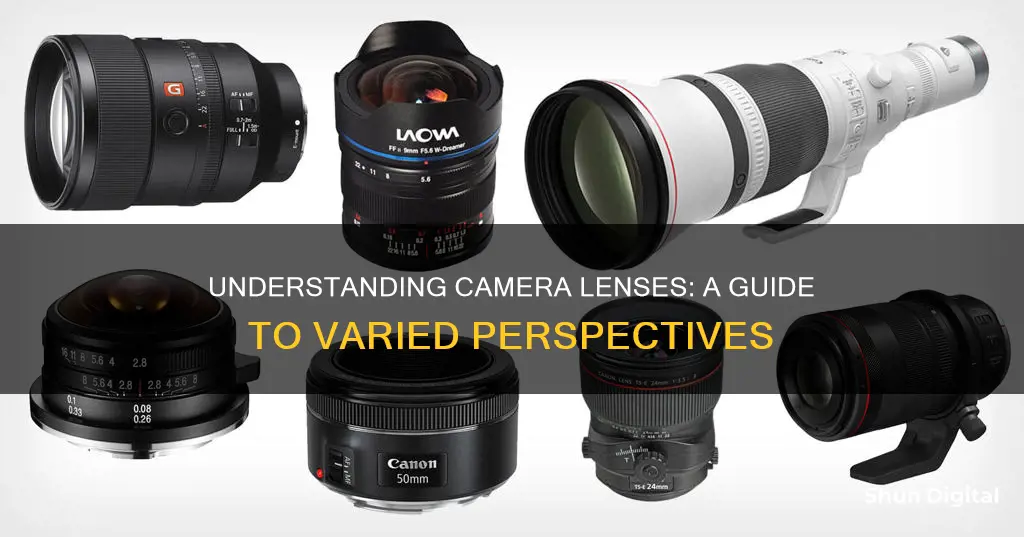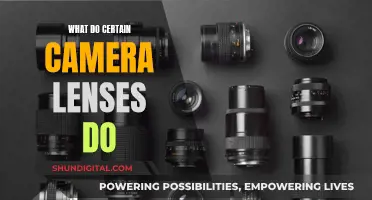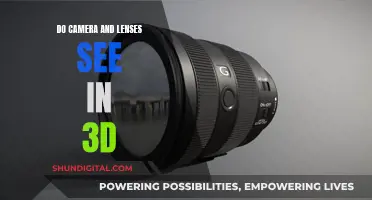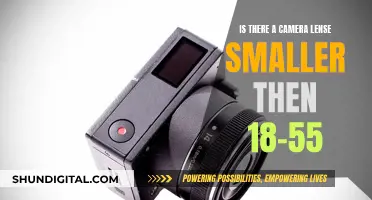
Camera lenses are a crucial component of photography, and understanding the differences between them is essential for capturing great images. Lenses play a similar role to the human eye, focusing light onto the camera's sensor or film to create an image. The two primary categories of lenses are prime lenses and zoom lenses, each offering unique advantages and applications. Prime lenses have a fixed focal length, delivering superior image quality for specific types of photography, while zoom lenses offer variable focal lengths, providing versatility and convenience.
Within these categories, there are various types of lenses, including standard, wide-angle, telephoto, macro, and tilt-shift lenses. Each lens type serves different purposes, such as landscape, portrait, sports, wildlife, and architecture photography. Understanding the characteristics and applications of these lenses empowers photographers to make informed choices, elevating their craft and resulting in more captivating images.
| Characteristics | Values |
|---|---|
| Lens type | Prime, Zoom, Telephoto, Wide-angle, Fisheye, Macro, Tilt-shift |
| Focal length | 24mm, 200mm, 70-200mm, 35mm, 14-35mm, 8-15mm, 40-200mm, 35mm, 100mm |
| Focal length range | 18-270mm, 18-55mm, 24-70mm, 35-70mm, 16-35mm, 10-22mm, 10-24mm, 14-140mm, 18-200mm, 55-250mm, 70-200mm, 10-24mm, 9-18mm, 16-600mm, 60-600mm, 500mm, 15mm |
| Aperture | f/2.8, f/4, f/1.8, f/1.2, f/4.5-5.5, f/3.5-5.6, f/2.8, f/16, f/2.8, f/4, f/1.8, f/4.5, f/3.5, f/5.6, f/1.4, f/1.8, f/2.8, f/4, f/3.5, f/5.6 |
| Aperture range | f/3.5-5.6 |
| Lens mount | EF, EF-S, EF-M, RF, F-mount, Alpha (A) mount, Micro Four Thirds, Canon EF-M, Fujifilm XF, Nikon 1, Sony E, Samsung NX, Pentax Q |
| Sensor size | Full frame, APS-C, Micro Four Thirds |
| Sensor type | DSLR, Mirrorless |
What You'll Learn

Prime vs zoom lenses
A prime lens has a fixed focal length, meaning it has a set angle of view that cannot be changed. The only way to make a subject appear larger is by physically moving the camera closer to it. Prime lenses have a single focal length, like 50mm, and come in all kinds of sizes, from fisheye to super-telephoto.
A zoom lens has a variable focal length, meaning the photographer can change the angle of view by turning the zoom ring. This allows the photographer to make objects appear larger or smaller without physically moving. Zoom lenses have two focal length specifications, like 70-200mm, indicating the two extremes of the zoom range.
Advantages of Prime Lenses
- Prime lenses are often significantly cheaper than zoom lenses.
- Prime lenses are usually smaller and lighter than zoom lenses.
- Prime lenses offer a wider aperture, allowing more light to enter the lens and creating a shallower depth of field. This results in better low-light performance and "bokeh", or beautifully blurred backgrounds.
- Prime lenses can help photographers learn composition and improve their technique by forcing them to "zoom with their feet".
Advantages of Zoom Lenses
- Zoom lenses offer greater versatility, allowing photographers to quickly change from wide-angle to telephoto without moving.
- Zoom lenses often feature image stabilization technology, allowing photographers to capture sharp images in low-light conditions without introducing blur.
- Zoom lenses reduce the need to carry multiple lenses, saving weight and reducing the need to swap lenses, which can result in a cleaner sensor.
The choice between a prime and a zoom lens depends on your specific needs and preferences. If you prioritise shallow depth of field, a prime lens is ideal. If you require more versatility, such as when travelling or shooting a variety of subjects, a zoom lens is a better choice. Ultimately, both types of lenses have their advantages and can produce amazing images.
The Intriguing Pricing of Camera Lenses: Factors and Features
You may want to see also

Focal length
The focal length of a lens is the distance between the focal point and the sensor. For a 50mm prime lens, the focal point is 50mm in front of the sensor.
Choosing Camera Lenses: A Guide to Shopping for Beginners
You may want to see also

Aperture
The aperture of a lens is controlled by an array of aperture blades that open and close, either manually or automatically, depending on the camera settings. The number of aperture blades can affect the quality of the out-of-focus areas in an image, known as bokeh. Lenses with more aperture blades tend to produce rounder and more pleasing bokeh.
The size of the aperture also determines the minimum focus distance of the lens, which is the closest distance at which the lens can focus sharply on an object. This is why prime lenses, which have fixed focal lengths, typically have wider maximum apertures than zoom lenses, making them well-suited for low-light photography and achieving shallow depth of field effects.
In addition, aperture settings can impact the sharpness of an image. Extremely wide apertures may compromise overall sharpness due to lens aberrations, while very small apertures can cause diffraction, resulting in a loss of sharpness. Most lenses have a "`sweet spot`" in the middle of their aperture range where they deliver the sharpest performance.
Switching Camera Lenses: A Step-by-Step Guide for Beginners
You may want to see also

Lens mounts
Camera lenses connect to camera bodies through lens mounts, which are mechanical and sometimes electrical interfaces. Lens mounts are a feature of camera systems that allow for interchangeable lenses, such as rangefinder, single-lens reflex, single-lens mirrorless, and movie cameras.
Bayonet mounts usually have tabs around the lens base that fit into recesses on the camera's lens mounting plate. These tabs are often "keyed" to ensure the lens is inserted in a specific orientation. Once inserted, the lens is turned slightly and locked in place with a spring-loaded pin.
- EF-Mount (Electronic Focus): Blackmagic URSA Mini, Canon 5D
- PL-Mount (Positive Lock): Blackmagic URSA Mini, Blackmagic Production Camera, RED EPIC MYSTERIUM-X
- F-Mount (Format Single-Lens Reflex): RED EPIC MYSTERIUM-X, RED SCARLET MYSTERIUM-X
- A-Mount (Sony 'Alpha' Series): Applicable to Sony Alpha cameras
- E-Mount (Sony Mirrorless): Applicable to Sony mirrorless cameras
- Z-Mount (New Nikon Mirrorless): Applicable to Nikon mirrorless cameras
- RF-Mount (New Canon EOS Mount): Applicable to Canon EOS cameras
- M43-Mount (Micro Four Thirds): Blackmagic Pocket Cinema Camera, Panasonic Lumix DC-GH5, Olympus OM-D E-M1 Mark II
- Canon EF Mount: Compatible with Canon full-frame and APS-C sensor cameras
- Nikon F Mount: Compatible with Nikon full-frame and APS-C sensor cameras
- Sony E Mount: Compatible with Sony mirrorless full-frame and APS-C sensor cameras
- Micro Four Thirds Mount: Used for mirrorless cameras from Olympus and Panasonic
- Fujifilm X Mount: Compatible with Fujifilm mirrorless APS-C sensor cameras
- Leica M Mount: Used for Leica rangefinder cameras with full-frame sensors
- Pentax K Mount: Applicable to Pentax DSLR cameras with full-frame and APS-C sensors
- Canon RF Mount: New mount for Canon mirrorless cameras with full-frame sensors
- Nikon Z Mount: New mount for Nikon mirrorless cameras with full-frame sensors
Camera Lenses: Expensive, Fragile, and Worthy of Insurance Coverage
You may want to see also

Wide-angle lenses
Standard wide-angle lenses have focal lengths from 24mm to 35mm and are considered "standard". This range allows you to get wide shots without too much distortion. However, if you want to open up tight spaces, such as cityscapes or small rooms, you may want to go wider than 35mm.
When using a wide-angle lens, it is important to watch out for distortion. Barrel distortion, where straight lines appear to bow outward, is common in photos taken with wide-angle lenses. This can be especially unflattering in portrait photography, so a higher focal length is usually chosen to avoid this issue. Additionally, try to avoid the temptation to point and shoot at the entire scene, as this can result in an image that lacks a focal point or effective composition. Instead, pay attention to the different elements in your frame and arrange them in a way that creates a strong image.
Prime lenses usually outperform wide-angle zoom lenses as they have fewer moving parts and can accommodate a wider maximum aperture. However, the difference in image quality is often marginal, and the convenience of a zoom range can make up for any sacrifice in image quality.
How to Eclipse-Proof Your Camera Lens
You may want to see also
Frequently asked questions
Prime lenses have a fixed focal length, meaning you can't zoom in or out. Zoom lenses, on the other hand, have variable focal lengths, allowing you to zoom from one number to another (e.g., 70mm to 200mm).
Standard lenses have a mid-range focal length, usually between 35mm and 85mm, and offer a similar viewpoint to the human eye. Wide-angle lenses, on the other hand, have a short focal length, typically ranging from 14mm to 35mm, allowing you to capture more of the scene in a single shot.
Telephoto lenses have long focal lengths, starting at 85mm, and are great for capturing distant subjects due to their magnification. Macro lenses, on the other hand, are designed for extreme close-ups, allowing you to capture tiny objects in great detail.







